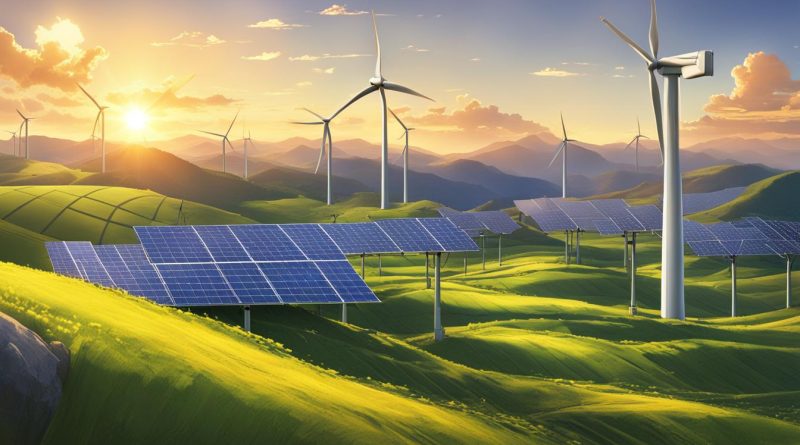Exploring Energy Stores: Types and Management
As the demand for renewable energy sources continues to rise, effective energy storage solutions have become imperative for unlocking the full potential of these alternative power sources. Energy stores play a critical role in ensuring that renewable energy systems are reliable and efficient, while also providing a more sustainable alternative to traditional fossil fuels.
This section provides an overview of energy stores, including various types and the importance of effective management for renewable energy storage solutions and systems. By exploring the different types of energy storage technologies and strategies for managing energy storage capacity, individuals and organizations can work towards achieving a more sustainable future.
Key Takeaways:
- Effective energy storage solutions are essential for the widespread adoption of renewable energy sources.
- Energy stores allow for more reliable and efficient energy systems while reducing our dependence on fossil fuels.
- Understanding the different types of energy storage technologies is crucial for maximizing energy storage capacity.
- Efficient management of energy storage systems can improve their performance and integration into existing infrastructure.
- The energy storage industry is rapidly growing, with promising opportunities for investment and innovation.
Types of Energy Stores
Energy stores are crucial for renewable energy storage and providing reliable and sustainable electricity. In this section, we will explore different types of energy stores and their unique characteristics, applications, and benefits in renewable energy storage.
Batteries
Batteries are one of the most commonly used energy storage technologies. They store electricity in a chemical form and can be charged and discharged multiple times. They are compact, easy to install, and have a high energy storage capacity. Batteries are ideal for grid stabilization, peak shaving, and load shifting. They are widely used in residential and commercial buildings, as well as in electric vehicles.
Pumped Hydro Storage
Pumped hydro storage is a cost-effective and reliable method of energy storage. It operates by pumping water from a lower reservoir to a higher reservoir during periods of low electricity demand. When electricity demand is high, the water is released back into the lower reservoir, driving turbines to generate electricity. Pumped hydro storage has a fast response time, high efficiency, and long lifecycle. It is mainly used for grid balancing and load shifting.
| Advantages | Disadvantages | |
|---|---|---|
| Advantages |
|
|
Compressed Air Energy Storage
Compressed air energy storage compresses air into a storage vessel and releases it through turbines when electricity is needed. It is an inexpensive and scalable form of energy storage that can balance the supply and demand of energy. Compressed air energy storage is perfect for off-grid applications, supporting microgrids, and balancing intermittent renewable energy sources such as wind and solar.
Thermal Energy Storage
Thermal energy storage stores thermal energy in heated liquids, such as molten salt or hot water. The stored thermal energy can be used to produce steam to generate electricity. Thermal energy storage is a cost-effective and versatile energy storage system that can store a large amount of energy with a long lifecycle. It is ideal for concentrated solar power plants and district heating systems.

Overall, there is a range of energy storage technologies that can help to improve the efficiency, reliability, and sustainability of renewable energy systems. The key is selecting the right technology for specific applications and effectively managing energy storage capacity.
Managing Energy Storage Systems
Effective management of energy storage systems is crucial in maintaining the optimal performance of renewable energy storage solutions. To optimize energy storage capacity and efficiency, several strategies can be implemented.
- Optimizing charging and discharging cycles: By optimizing charging and discharging cycles of energy storage systems, the overall performance and lifespan of the system can be improved. This involves developing smart algorithms that determine the best time to charge and discharge the energy storage system.
- Efficient operation: By ensuring efficient operation of energy storage systems, the energy stored can be used effectively, reducing energy wastage. This involves regular maintenance of the system, monitoring performance data, and identifying potential faults.
- Integrating energy storage technologies: Integrating energy storage technologies into existing infrastructure can create a more reliable and stable energy system. This involves the use of advanced energy storage solutions with higher energy storage capacities, reliable and intelligent microgrids, and power electronics.
The current state of the energy storage industry is evolving rapidly, with opportunities for innovation and growth. According to the latest market research, the global energy storage market size is expected to reach $54.7 billion by 2027, growing at a CAGR of 24.2% from 2020 to 2027. This growth is driven by the increasing adoption of renewable energy systems and energy storage solutions across various industry sectors, including residential, commercial, and industrial.
To remain competitive and meet the growing demand for energy storage systems, companies in the energy storage industry must continue to innovate and develop new energy storage solutions. This can involve investing in research and development, partnerships and collaborations, and exploring new markets.

Conclusion
In conclusion, understanding the different types of energy stores and effectively managing energy storage systems is crucial for the widespread adoption of renewable energy solutions. By maximising energy storage capacity and implementing innovative storage technologies, we can enhance the reliability and sustainability of our energy systems. It is imperative for businesses and governments to invest in research and development of energy storage solutions to meet the needs of an evolving energy landscape.
The energy storage industry has witnessed significant growth over the past few years, driven by advancements in technology and increased renewable energy deployment. As the demand for sustainable energy solutions continues to rise, the market for energy storage systems is expected to expand further.
Moreover, effective management of energy storage systems can help reduce reliance on fossil fuels, improve energy security, and mitigate the impact of climate change. The integration of energy storage technologies into existing infrastructure can also provide new revenue streams and create job opportunities.
In summary, energy storage plays a critical role in unlocking the potential of renewable energy. By continuing to innovate and refine energy storage technologies, we can achieve the goal of a cleaner, more sustainable energy future.
FAQ
What are energy stores?
Energy stores are systems or devices that store energy for later use. They allow for the capture, conversion, and release of energy in different forms, such as electrical, kinetic, potential, or thermal energy.
What is the importance of energy storage?
Energy storage plays a vital role in the renewable energy sector as it helps address the intermittency and variability of renewable energy sources. It allows for the efficient use of excess energy during times of low demand and provides a reliable supply during peak demand periods.
What are the different types of energy stores?
There are several types of energy stores, including batteries, pumped hydro storage, compressed air energy storage, and thermal energy storage. Each type has its own unique characteristics and applications.
How do batteries work as energy stores?
Batteries store energy in chemical form and convert it into electrical energy when needed. They consist of one or more electrochemical cells that contain a positive electrode (cathode), a negative electrode (anode), and an electrolyte. Batteries are versatile energy storage solutions and widely used in various applications.
What is pumped hydro storage?
Pumped hydro storage utilizes the potential energy of water by pumping it to a higher elevation when excess electricity is available. During times of high demand, this stored water is released, flowing downhill through turbines to generate electricity. It is one of the most commonly used and reliable forms of large-scale energy storage.
How does compressed air energy storage work?
Compressed air energy storage (CAES) involves compressing air and storing it in underground caverns or tanks. When electricity demand rises, the pressurized air is released, generating power by passing through a turbine. CAES provides a flexible and responsive energy storage solution.
What is thermal energy storage?
Thermal energy storage involves storing energy in the form of heat or cold. This can be achieved using various methods such as phase change materials, sensible heat storage, or thermochemical storage. It allows for the efficient utilization of waste heat or surplus energy.
How can energy storage systems be effectively managed?
Effective management of energy storage systems involves optimizing energy storage capacity, monitoring and controlling charging and discharging cycles, implementing predictive algorithms, and integrating storage technologies into the overall energy infrastructure. It also requires regular maintenance and performance monitoring.
What is the current state of the energy storage industry?
The energy storage industry is experiencing rapid growth and technological advancements. There is an increasing demand for energy storage solutions to support the integration of renewable energy sources and enhance grid reliability. The industry is also witnessing a decline in costs, making energy storage more accessible and economically viable.
What are the market trends in the energy storage industry?
The energy storage market is expanding globally, driven by the growing need for clean and reliable energy sources. Key market trends include the rise of lithium-ion batteries, the integration of energy storage with renewable projects, the development of large-scale projects, and the focus on grid modernization and energy resilience.




